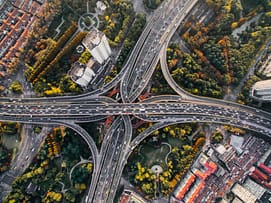Freight in Beijing is essential to provide goods to the city’s 20 million residents. Yet this comes with tremendous impacts: air pollution, carbon emissions, and traffic and congestion, to name just some. Efforts for change have so far come with mixed results. Working with the Smart Freight Centre, we delved into the system’s complexities to uncover structural issues behind these problems and provide a holistic strategy for change. Here Oscar Sabag outlines how even a city as complex and vast as Beijing can change, and the lessons this provides for other cities around the world.
Like the rest of China, Beijing has seen tremendous transformations in the last few decades, now becoming a complex megacity with a rich variety of industries and economic activities, as well as becoming a cultural and political hub.
China’s capital bustles with over 20 million residents, more than the entire Netherlands. These citizens enjoy rising standards of living and demand all types of goods delivered to warehouses, distribution centers, and even their homes and offices. Every day, tons of food, clothes, construction materials, vehicles, and other goods enter and move through the city, posing important challenges to the city’s freight and logistics sector, and competing with other transportation needs from citizens.
Beijing’s freight sector is a seemingly contrasting tripartite collection where modern multinationals with international standards and operations, public companies that dominate specific sectors (like rail), and a huge fleet of traditional carriers and logistics providers all operate next to each other. This third part, the traditional sector, includes tens of thousands of individual drivers, working with their own (often old) trucks, and logistics companies consisting of a couple of brokers assigning freight orders by phone or live auctions. The system is inefficient, and results in a series of social, environmental, and economic problems that the city is aware of and responding to.
Beijing is now exploring the development of a Green Freight Strategy through which the city plans to modernize the system into the 21st century. The Smart Freight Centre (SFC), a global organization with the objective of making freight more sustainable, collaborates with Beijing’s Transport and Environment Centre to find solutions to the city’s freight system and bring international expertise and experiences to Beijing.
Metabolic provided input into this process. As we have done when we address the sustainability challenges faced in other economic sectors or geographic contexts, we used a systems thinking approach. This means taking a holistic look at the problems at hand, with all their interactions that give shape to the system’s behavior. Our goal in this case was to identify what the underlying problems were, so that we could arrive at strong solutions for real change.
To start our journey into the system, we chose three of the most salient and concerning freight-related impacts in the city: air pollution, inefficient fuel use and the resulting high carbon emissions, and traffic and congestion. We then worked our way back through the system’s dynamics, uncovering its fascinating complexities. A contrasting reality became apparent. Beijing has environmental and energy standards on par with Western countries, and has implemented many solutions to address the system’s freight issues: bans to obsolete vehicles, restricted access areas, ever higher fuel standards. Yet air pollution, carbon emissions, and traffic continue getting worse. A small slice of the system consisting of obsolete trucks, overloaded beyond their capacity, running on dirty fuel, and without any support from modern logistics planning, contributes disproportionately to these problems.


Why haven’t the government’s actions resulted in the positive changes expected for the city?
In other words, why has the system been so reluctant to change?
The reason lies in systemic structures – economic and institutional interactions – that entrench these problems. A cycle of economic constraints makes improvement unaffordable and slowly deteriorates the capital base, while institutional weaknesses offer gaps for constrained actors to bypass governmental efforts for change.
Beijing has a very fragmented and decentralized system with an excessive – seemingly endless – supply of carriers and logistics providers. The only way to compete in this market has been to bring down prices. Coupled with the inefficient practices and vehicles that arise from using old technology, profits make investment in maintenance or modernization impossible – closing a reinforcing cycle. Normally these agents should not operate or even enter the city, but bribes, insufficient fines, and a couple of mismatches between regulations and territory, allow plenty of ways in, despite the non-compliance.
Therein lies the beauty of a systems thinking approach. It’s now clear – obvious even – that in this context interventions at the level of spatial arrangements, investment in infrastructure, or requirements in technology upgrading are quite futile.
We translated these insights into a series of inputs to support Beijing in developing a Green Freight Strategy from a holistic perspective. We paired possible solutions that dealt with immediate and urgent problems, such as modernizing the technological base, inducing a collaborative integration of the sector, and integrating freight into the public space, with those that tackle the system’s fundamental challenges and root causes in the economic and institutional spheres.
We hope our input will contribute to the formulation of more holistic strategies to tackle Beijing’s freight challenges and inspire cities across China and in other countries to take similar action. While the context in Beijing is unique to the city, the foundation of systems thinking are very much transferable to other cities and regions – whether to address transportation or the challenges of any other economic sector.
Would you like to learn more about this project?
You can read our full report or contact us with any questions.







